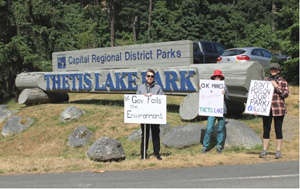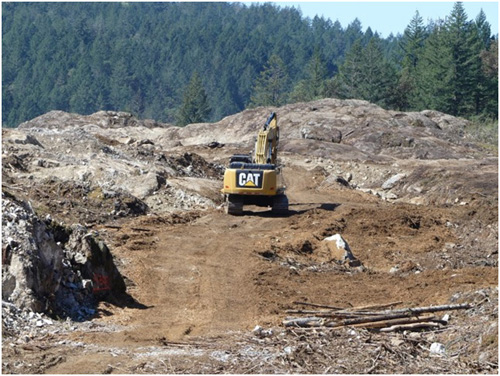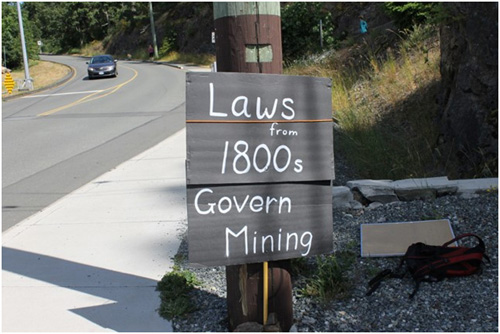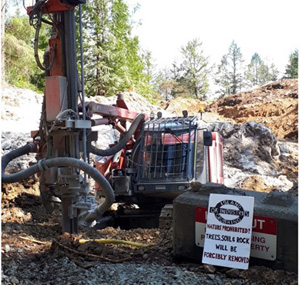Thursday June 10, 2021 | HIGHLANDS, BC
by Jalen C Codrington | Island Social Trends | Editor: Mary P Brooke
Nestled within the District of Highlands is a seemingly unassuming 65-acre property, bordering the Millstream Industrial Park to the south, and a now contaminated landfill to the north. The district had even earmarked the property as a potential commercial industrial zone. It seemed like the perfect spot for the O.K. Industries (OKI) new strip-mining quarry. No one would have guessed that for the next few years, this property would prove to be a site of such major contention.
OKI is a local company — family owned and operated — employing over 200 people across the island. Their main business is Island Asphalt, which supplies asphalt to every municipality south of the Malahat, paving everything from roads and bike lanes to airplane runways. The paving substance is comprised of roughly 5% liquid asphalt, and 95% aggregate.
In January 2015, OKI purchased the 65-acre property from the BC government for $4.2 million. The company plans to extract aggregate from the quarry, and transport it to their plant in downtown Victoria. After the quarry’s life is over, OKI plans to leave the land level, so it can be rezoned for a use consistent with the district’s official community plan.
For OKI, it all seemed too good to be true. “We get the rock,” said Mel Sangha, former General Manager, and current Corporate Advisor for OKI, “the regional area gets the land to use down the road, our employees get to work, our local suppliers…they also get work, and Highlands immediately gets a big increase in tax base.”
Rezoning challenges:
But in 2016, when OKI applied to rezone the property for industrial usage, they were met by unanimous opposition from both the District of Highlands, and the Highlands District Community Association (HDCA). The District of Highlands is a small population of only about 2,500 residents, yet it seems the entire community has rallied in opposition to OKI’s operations.
Karen Burns is the spokesperson for NotOK – a group of Highlands citizens concerned with the effects of the quarry – and former councilor for the district. “The Highlands is a super green space,” said Burns, “and we really pride ourselves on the amounts of parks that we’ve protected for the whole region.”
Burns also indicated worries about noise and dust pollution, increased road traffic, and overall environmental degradation. But perhaps the most salient issue, is the possible impact on the underlying aquifer, which supplies drinking water to the district’s wells. Burns says the adjacent the adjacent Millstream Meadows (used for septic discharge dating from approximately 1941 to closure in 1985) landfill has already begun leaching offsite into drinking water. The CRD has since spent over $14 million on Millstream Meadows remediation, involving measures to prevent leaching.
Protecting water & natural topography:
A 2004 study found a total of 24 different aquifers beneath the CRD area, above which numerous industrial and commercial activities take place. The aquifer underlying the District of Highlands is 209 sq km, and stretches all the way to Oak Bay. The aquifer is considered “moderately vulnerable” to contamination from surface pollutants. Numerous contaminated sites exist overlying the aquifer; however, says the study, no associated impact to water wells have been documented.
“For us and the people living there and the people in this region,” said Burns, “do you really want to hear blasting and have rock crushing and all the dust…for 16 to 25 years just so somebody can make a profit?”
Suitable location:
When asked by Island Social Trends as to why the quarry was built in its current location, Sangha said that having a rock source closer to the asphalt plant in downtown Victoria means not only reduced transportation costs, but fewer trucks congesting and wearing down the CRD’s roads. As well, fewer diesel trucks on the roads means less greenhouse gas gets released into the air. Also, he felt the adjacent contaminated landfill, which cannot currently be developed for any other purpose, would act as an effective buffer zone between the quarry and the rest of the region.
Despite the original plan to rezone the property for commercial and industrial use, Burns said that the HDCA never imagined a quarry would be built there. She said the mayor and council at the time envisioned a business park resembling something like Vancouver Island Technology Park, “where a lot of the natural setting, landscape and topography would be preserved.”
Mines permit approved:
After the unsuccessful rezoning application, OKI went to the BC Ministry of Energy, Mines, and Low Carbon Emissions to apply for a Mines Permit. In conjunction with their application, OKI paid for numerous third-party assessment groups to determine the environmental impacts of the project. These groups offered numerous recommendations to mitigate environmental degradation, including large buffer zones to separate the project from Thetis Lake Park to the east, and the Highlands residents to the west. The ministry vetted this application, which contained all of the concerns identified by the district, and ultimately approved the project. The permit, issued in March 2020, overrode all of the District of Highland’s municipal procedures.
The district felt backstabbed. The provincial government had swooped in, and brushed aside all of their community’s objections. The HDCA quickly filed an application to the BC Supreme Court for a judicial review of the quarry approval.
Burns described OKI’s applying for the Mines Permit as going over the district’s heads to bypass their municipal authority. Sangha said OKI was very transparent with the district from the start, and informed them that were the rezoning application rejected, the company would apply for a Mines Permit.
“Had they proceeded with rezoning,” said Sangha, “they would have issued a land development permit that they would have been in absolute control of. When they chose to reject the rezoning and we applied for a mines permit, they basically gave up the ability to control the land.” Sangha said he attended multiple meetings with the district, and felt that it was extremely important for his company to be transparent.
OKI began clearing trees at the site in October 2020. On October 3, the district issued OKI a “cease work order” on the basis that the tree-cutting activities were taking place without a valid permit. The company was informed that numerous other bylaws might be triggered if work was to continue.
When it came time for the hearing, the BC Supreme court ultimately ruled that OKI’s quarrying activities fell under provincial mining legislation, and therefore could not be hindered by municipal bylaws.
Getting on with business:
Meanwhile, the folks at OKI, who had fully complied with all provincial proceedings, were left feeling somewhat bewildered by the backlash. “I just don’t know what else our company could have done to comply with the laws and the regulations of the province to meet and address these concerns,” said Sangha.
Now, in 2021, not only the District of Highlands Mayor Ken Williams and council, but the HDCA, and also NotOK are each taking their own avenues to fight the development.
District of Highlands appeal:
The district has since elected to pursue an appeal of the supreme court decision.
The statutory decision-maker is required to assess environmental issues resulting from project. However, the HDCA says the decision-maker did not investigate the climate change impacts this project would have. That hearing is expected to occur later this year.
Highlands Mayor Ken Williams only offers the district’s original press release concerning the appeal as comment at this time.
Community group protest:
NotOK has been staging protests at the entrance to the mine site since the beginning of February. Their signs can be seen nailed to trees and dotting the path all along Millstream Road. Last Saturday (June 5), Highland residents took to Thetis Lake to raise awareness of the quarry, and out-of-date mining policies.
With the ongoing legal dispute between the OKI and the district, neither party has sat down to discuss the project since the zoning proposal was first rejected in 2016. Despite this, Sangha says OKI remains fully committed to meaningful engagement with the district.
But both Sangha and the District of Highlands agree there is a much larger issue at play here, one which neither party can directly change. It’s obvious that the district is dissatisfied by the permit process, as well as the provincial government’s authoritarian ability to override the decisions of their small community.
Adapting policies for the modern day:
At the end of the day, this issue boils down to Gold Rush-era mining policies. Scott Richardson, Chair of the HDCA, said the BC Mines Act is from a remnant of a time where the government had an “extractivist mentality.” Under the current provincial mining policies, companies can stake claims in ecologically sensitive areas, within First Nations territories, and even on private property. Therefore, mine workers are not subject to zoning bylaws, or the land-use plans that would apply to other industries.
“The Mines Act was built in a time when they were trying to settle the province,” said Burns. “And so all the laws are from that time. And that doesn’t make sense in this day and age, especially when we have a climate crisis, and especially when we have loss of biodiversity.”
From the corporate perspective, Sangha said the Mines Act is not an issue for him or OKI to help solve, but is an issue for the politicians to deal with.
Meanwhile, advocacy groups, such as the BC Mining Law Reform, are already working to update provincial mining policies. “We don’t want mining claims to undermine land use planning, Indigenous rights, municipalities, environmental protection, and private property any longer,” says the group. “B.C.’s laws should require Indigenous consent and meaningful public participation in the assessment of mining activities.”
The organization, in conjunction with the University of Victoria Environmental Law Centre, has provided nearly 70 recommendations to improve regulation of the mining industry. The recommendations include ensuring that no mining take place without the informed consent of affected indigenous communities, and that all development activities conform with all local and regional land-use plans.
In the premier’s riding:
Richardson said that the HDCA has met on multiple occasions with Premier John Horgan, whose electoral riding of Langford-Juan de Fuca encompasses the District of Highlands. He said Horgan expressed awareness that the Mines Act needs to be updated, but made it clear that his hands are tied on the matter.
Despite this, Richardson said he has “great hope that the government sees the need for change,” and is expecting to see that reflected in future on-the-ground decisions. This is, after all, the government who changed the name of the Ministry of Energy, Mines and Petroleum Resources, to the Ministry of Energy, Mines and Low Carbon Innovation. Hopefully, future legislature will reflect the BC NDP’s promises to create a sustainable and competitive economy, one which supports indigenous reconciliation, reflects high environmental standards, and respects the wishes of local communities.
NotOK encourages British Columbians to write to the following politicians and request that the Mines Act be updated:
- Bruce Ralston, the Minister of Energy, Mines, and Low Carbon Innovation at EMPR.Minister@gov.bc.ca
- George Heyman, the Minister of Environment and Climate Change Strategy at ENV.Minister@gov.bc.ca
- Premier John Horgan, at john.horgan.mla@leg.bc.ca
===== About the writer:
Jalen C Codrington is a 4th-year University of Victoria student (Philosophy and English) who is a summer student writer and copy desk editor with Island Social Trends.











